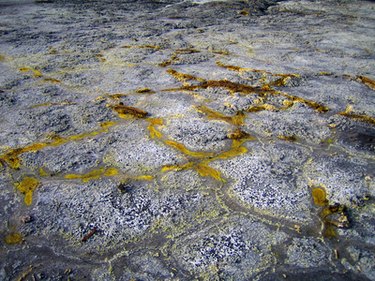
Pure water is tasteless, but water is a strong natural solvent and will dissolve minerals that may give it an odor or flavor. When sulfur gets into groundwater, naturally occurring bacteria can reduce the organic sulfite ores and produce hydrogen sulfide gas. Sulfur is more likely to be found in well water than in municipal water.
Sulfur in Drinking Water
Video of the Day
Sulfates, which are a form of the element sulfur, most commonly get into the water supply when sulfite ores are oxidized. Sulfur-containing minerals are found in most rocks and soils around the world. As groundwater seeps through the earth, some of these sulfur compounds are dissolved by the water. Rainwater is also a source of sulfur.
Video of the Day
Bacteria use sulfur in the soil as a food or energy source, and then they produce hydrogen sulfide gas as a byproduct of their metabolic functions. Water that contains hydrogen sulfide is quickly recognizable by its sulfurous odor. Ingesting water that contains sulfur is not a health risk, but it can be unappetizing.
Sulfur’s Role in Human Nutrition
Sulfur is found in many of the foods that you eat, such as eggs, fish, poultry and legumes. It is widely believed that ingesting foods that contain sulfur is good for the hair, skin, nails and connective tissue. A well-balanced diet will provide you with all the sulfur that you need, but if you are a vegan you may need to supplement your diet.
Large quantities of sulfur in drinking water can contribute to diarrhea, which leads to dehydration. Livestock and pets are also susceptible to the effects of sulfur in their drinking water. The Environmental Protection Agency notes that when you abruptly switch from drinking water that does not contain sulfur to drinking water that is high in sulfur content, you are most likely to experience laxative effects from the mineral. However, most humans and animals are able to adapt to the amount of sulfur in water and will generally experience no lasting detrimental effects.
The Problems of Sulfur
The biggest problem of sulfur in drinking water is that it stinks. Like other minerals, sulfur can leave stains in plumbing fixtures such as sinks and toilets. Clothing washed in water that is high in sulfur may also become stained. Water that contains as little as one part per million of hydrogen sulfide can tarnish copper and silver.
The bacteria that produce hydrogen sulfide gas produce slime, which can be white, gray or black. These sulfur bacteria can create conditions favorable to other bacteria, including iron bacteria, in which case you might see a reddish-brown slime. Any of those slimes will coat plumbing pipes, which will cause clogs and lead to corrosion.
Sulfur-containing water can be treated with chlorine to remove the sulfur. Chlorinated bleach can be added to water, and the hydrogen sulfide gas will react with the chlorine and settle out as yellow particles, which can be mechanically filtered out of the water.
The Environmental Protection Agency and the Centers for Disease Control and Prevention conducted a study to determine the health effects of sulfur. This research, titled “Health Effects from Exposure to High Levels of Sulfate in Drinking Water Study,” concluded that drinking water with high levels of sulfate can cause diarrhea, especially in infants.